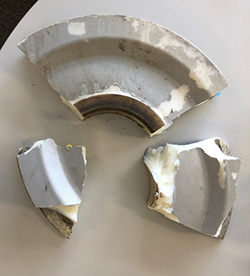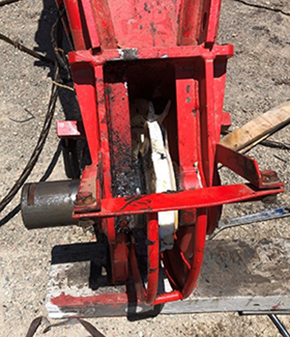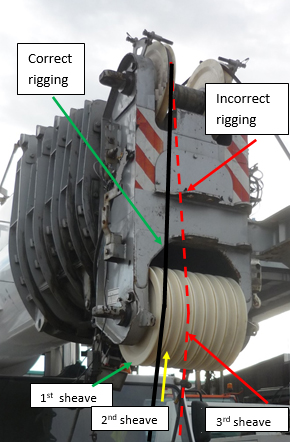Crane rope sheave failures
Issued: 21/06/2019
Last Updated: 03/01/2020
Purpose
The purpose of this safety alert is to highlight the risk of rope sheave failure on mobile cranes. Crane owners, crane operators and workers involved in rigging cranes should apply the principles in this alert to any crane with rope sheaves.
Background
Last year in Queensland, there were two incidents where plastic (nylon) crane rope sheaves catastrophically failed.
In the first incident, a plastic sheave on a 130-tonne hydraulic mobile crane failed and broke into pieces during an attempt to lift an 8-tonne load on the main winch rope (refer Photograph 1). As the sheave failed, the load dropped a short distance and applied shock loading to the hoist rope, damaging it. The main winch was rigged with three parts (falls) of rope. The sheave that failed was a top sheave on the end of the hydraulic boom. On this crane, the hoist rope passes through the top sheave and then down to a sheave on the bottom of the boom tip before passing down to the hook block.
In the second incident, a plastic rooster sheave on a 180-tonne lattice boom mobile crane failed (refer Photograph 2). The crane was being used to lift a 12.5-tonne dumb barge off the back off a truck when the sheave failed. Before the crane could completely lower the barge to the ground, the hoist rope broke and the barge dropped.
Fortunately, no-one was injured in either incident. However, both had the potential for more serious consequences.
Contributing factors
In the first incident, it appears the main reason was the hoist rope applied a side loading to the sheave, caused by misalignment from incorrect rigging of the hoist rope. Instead of the hoist rope passing from a top sheave to the sheave directly below (so that it is close to vertical), it passed from the top sheave to the third sheave along (refer Photograph 3). Sheaves are designed to freely rotate with negligible side load.
It is acknowledged that when rigging a mobile crane in multiple falls (parts) of rope, there will be a slight rope angle between sheaves due to the position of consecutive sheaves. In this configuration, when the hook block is hoisted down, this angle will reduce as the sheaves move further apart. Consequently, for a given load, the side loading applied to the sheaves will also reduce. However, for a misaligned rope on the end of a crane boom, the distance between the top and bottom sheaves stays the same and the associated side loading remains constant when the hook block is hoisted up or down.
 Photograph 1: Failed sheave segments (130-tonne crane)  Photograph 2: Failed rooster sheave (180-tonne crane) |  Photograph 3: Example of correct and incorrect rigging on boom head (note: rope keeper bar removed for clarity) |
In the second incident, it appears the sheave may have had inadequate strength for the additional potential side loading experienced by rooster sheaves. Since the incident, the sheave has been replaced with a reinforced sheave that can withstand greater potential side loading.
Action required
Mobile cranes are to be rigged in accordance with the manufacturer's instructions. The rigging set up should ensure when a rope passes from one rope sheave to another, the consecutive sheaves are aligned as closely as possible.
Potential side loading increases if, while the crane is operated, the hoist rope does not remain vertical. For example, if the crane is slewed rapidly and/or is slewed before the load is completely lifted off the ground, side loading can dramatically increase. On rooster sheaves, where there's only one fall of rope, there can be a greater tendency for side loading due to the rapid hoisting speed, and the propensity for the crane to be operated quickly. To reduce the likelihood of side loading on sheaves, it is important all cranes are operated smoothly and in compliance with both the crane operator's manual and safe lifting practices. If inspection shows the reeving is incorrect and excessive side load is being applied to the sheaves, the sheaves should be thoroughly inspected and, if necessary, replaced with new sheaves that comply with the crane manufacturer's specifications.
Regular inspection and service of all rope sheaves should be carried out in accordance with the crane manufacturer's instructions during the crane's periodic safety inspections. All sheaves should freely rotate without excessive end play. Damaged and worn sheaves are to be replaced. At the major inspection, all rope sheaves should be removed from the crane and closely inspected for both their condition and operation. Sheaves should not be painted. Information on ways to identify worn, damaged or otherwise degraded plastic rope sheaves should be requested from the crane manufacturer.
Further information
Further information can be obtained from the following:
- Mobile crane Code of Practice 2024 (PDF, 2.29 MB)